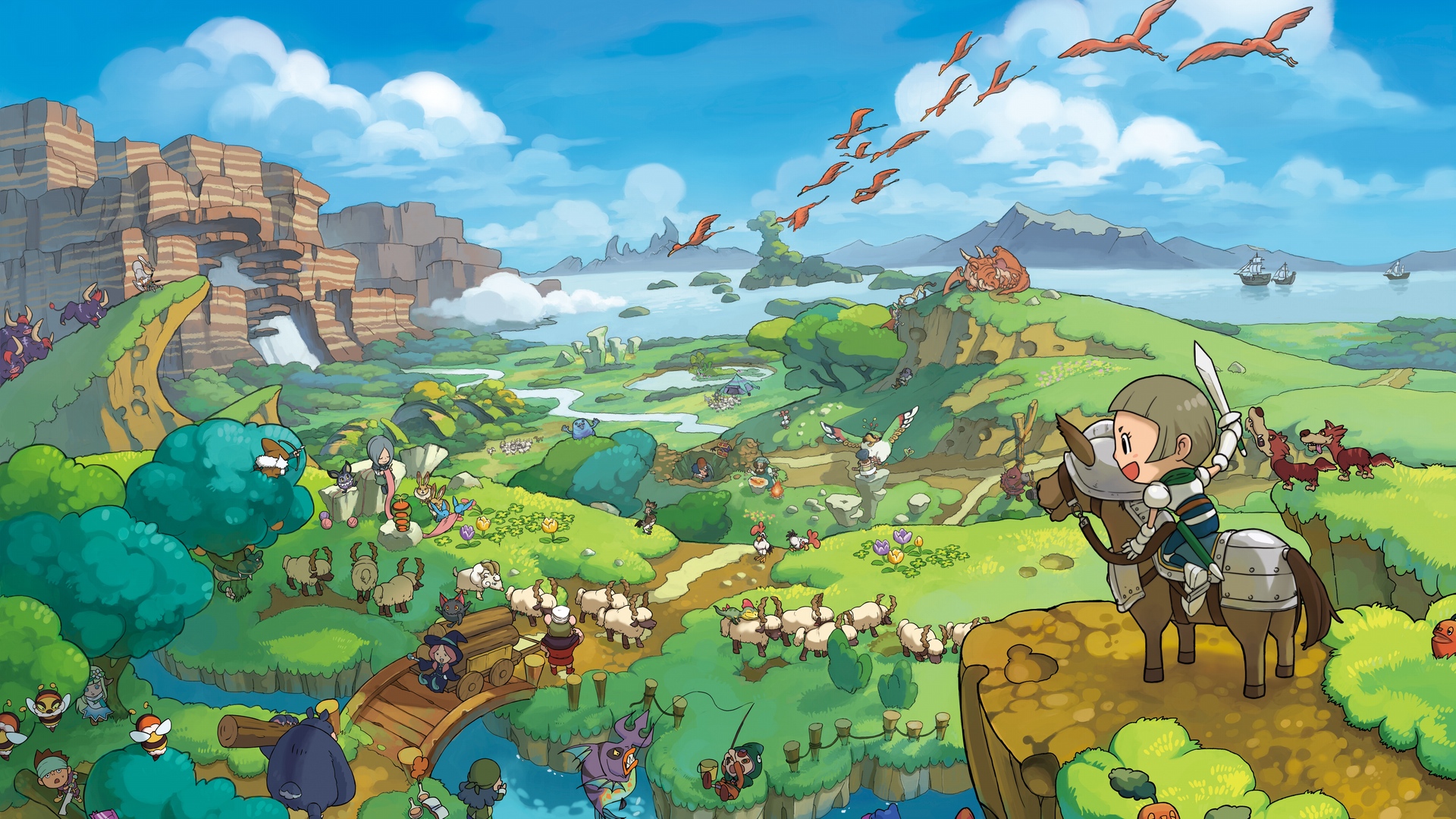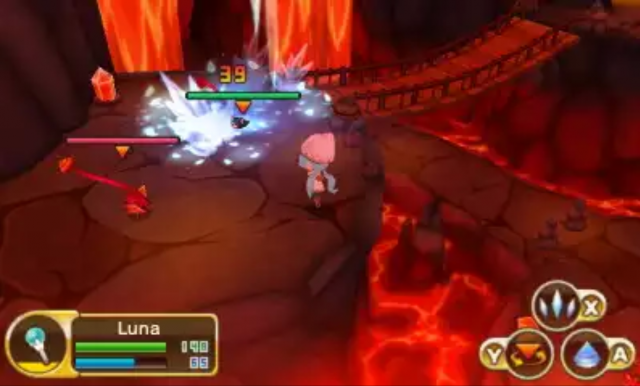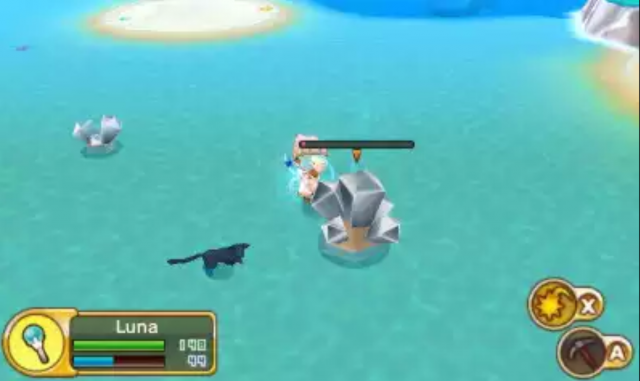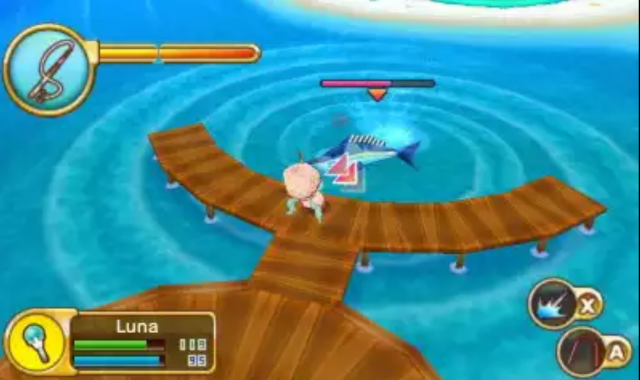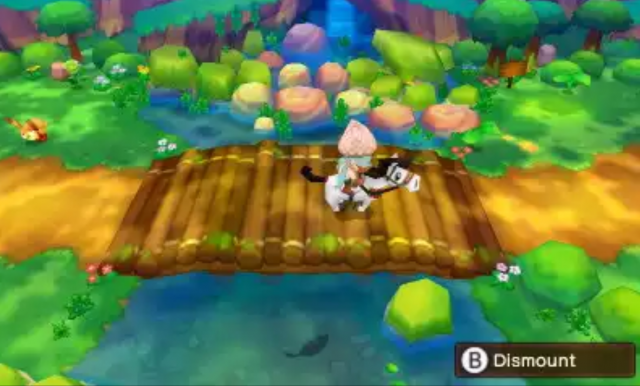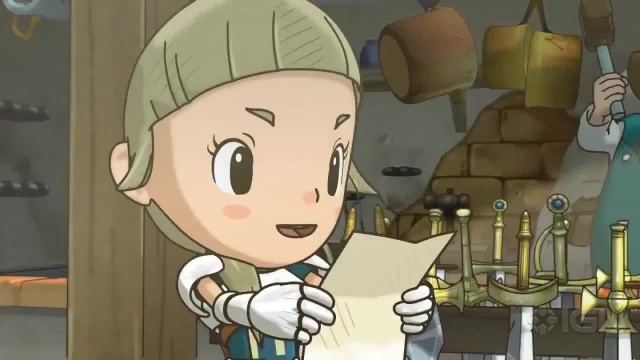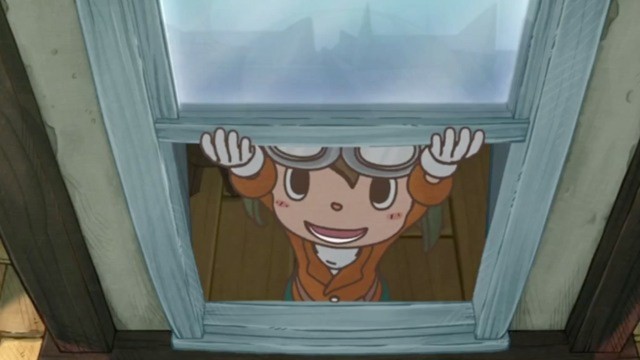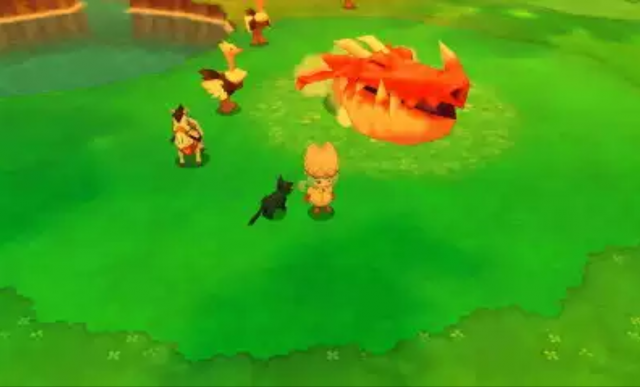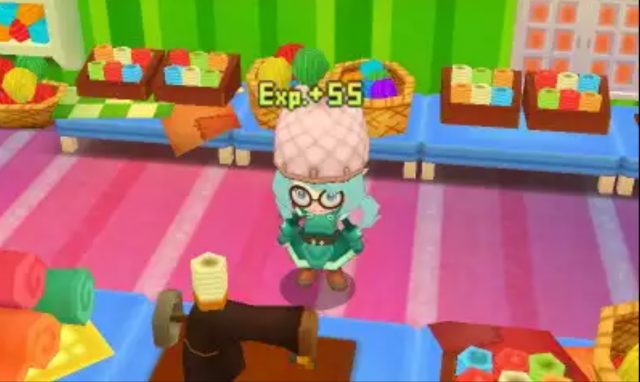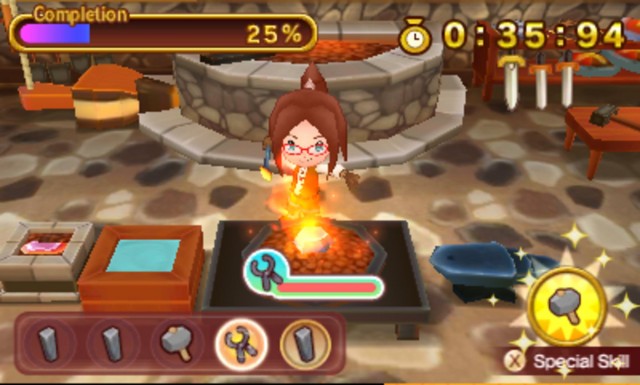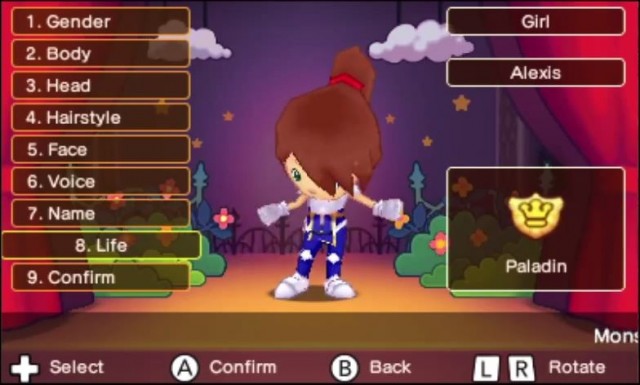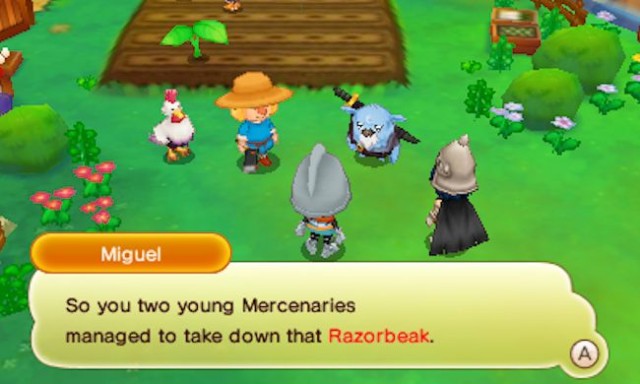As much as many RPG gamers dream of the glory of slaying monsters, making money, and living in a big house full of treasure, there’s also a nobility in the simpler things. What if you entered a fantasy world with the preference of living a quieter life? What if you’d rather be a cook? Or a tailor? Or a miner? Heroes need to eat, clothe themselves and have their weapons forged by someone, after all. Maybe one would prefer to be that someone, over being the paladin, wizard or hunter in the actual fray of battle.
In Fantasy Life for 3DS, you choose the life you want. You can be a more traditional RPG hero if you wish, mastering the sword techniques of the mighty paladin, or the sorcery of the crafty wizard, or you can devote yourself to a different craft. Maybe you would rather gather materials to become an alchemist, or find ingredients for that perfect recipe as a chef. Hell, maybe you’d like to dabble a bit in all twelve of the game’s potential professions, which you can swap between at any time, until you find your favourite calling. After all, in this game, the heroes aren’t necessarily just the ones devoting their life to monster slaying!
This makes for an interesting game that blends the domestic peace of Animal Crossing or Harvest Moon, with a highly customizable, extra cutesy RPG experience akin to a pocket-sized version of The Elder Scrolls or Dragon Age. In fact, if you’ve already indulged in the Rune Factory series, a more RPG-like spin-off of Harvest Moon, you should have the best idea of what Fantasy Life is like going in. It could be taken as an RPG, a virtual life sim, or a bit of both.
But is it any good? Well, yes, but it’s not without structuring and pacing issues. As with real life, there can be a lot of repetition in Fantasy Life, and that can hurt its long-term appeal to some. Still, it’s difficult to ignore the game’s freedom and friendliness, so those looking for an accessible RPG/life sim blend will find it worth checking out, even if it won’t replace either genre’s biggest mainstays in the 3DS library.
Fantasy Life’s colourful, detailed visuals look fantastic, and illustrate the world of Reveria with an insane amount of charm. Every character looks distinct and loveable, and even the monsters look surprisingly adorable. In an industry rife with dark, bloody RPG’s marketed wholesale to adult audiences, it’s refreshing to see a game with RPG sensibilities that isn’t afraid to just be innocent and cute.
Developer, Level-5 has done fantastic visual work with Nintendo handhelds in the past, and they don’t disappoint in Fantasy Life. The incredible amount of detail in both the character sprites and environments is very impressive, even if the sprites do animate a bit stiffly, largely relying on Japanese-style anime prompts to convey emotions over silent text boxes. Still, it’s impossible not to fall in love with Fantasy Life just by looking at it. It’s both impressively detailed and relentlessly adorable, and even when you rally a group of Nintendo Network friends to adventure with you online, the game’s performance holds up well. It’s a fine showcase of what the 3DS line of handhelds can do!
Players also get plenty of means to customize their player character, with an assortment of physical features, hairstyles and whatever else to give them when you first start the game. You can even choose whether your hero is young or old, big or small, and, naturally, whether they’re male or female. Regardless of what you come up with, you’re sure to generate a cute-looking hero, and the fact that your character’s custom sprite gets their equipment and clothes changed in-game as you equip different things is also a great touch!
As for the 3D effects, they’re pretty good, adding some increased immersion to general exploration and cutscenes for the most part. You could easily get by without them if you’re playing on a 2DS, or simply opt to flick off the 3D Slider however, as Fantasy Life still looks plenty appealing in 2D. Still, the 3D work is pretty mellow and inviting, as with everything else, so if you prefer to play 3DS games in 3D, you’ll feel that it brings you into the game a bit more, and helps to give everything a slightly added sense of scale.
Whether in 3D or 2D though, Fantasy Life is packed with charm, and is a joy to see unfold. It delivers vibrant visuals with loads of detail, and successfully creates a loveable world that you won’t want to leave!
Veteran Final Fantasy composer, Nobuo Uematsu has been contracted by Level-5 to compose the music for Fantasy Life, and as usual, he’s done sublime work! The quaint musical score is both soothing and vaguely silly, rife with kazoos and squeaks in many places, perfectly selling the cutesy atmosphere. There are a handful of more ambient and adventure-style tracks to go with the RPG-style exploration however, and those sound fantastic as well. Even the game’s battle themes are all about charm, and don’t really carry any punch, but that doesn’t make them any less appealing to hum along with as you play.
Sound effects are predictably simplified and cartoonish, with even heated battles against larger bounty monsters feeling more like loveable slapstick than a violent struggle to the death. Enchanting sound cues help to increase the game’s charm even further, just as fanfares for leveling up and other such bonuses will effectively celebrate the RPG spirit. Some of the sound effectively harkens back to classic 16-bit RPG’s, in a great way, generating a great blend of high adventure and comforting charm, much to Fantasy Life’s benefit.
The game is mostly devoid of voice acting, with the entire story being told in silent text. Still, you can customize your silent, self-made protagonist’s in-battle voice, which gives them their own unique attack yelps and death cries. It’s a pretty small touch, but it can help to separate your character’s battle reactions from those of your friends’ characters, and A.I.-controlled story allies, pretty nicely.
The quaint audio work is very well-done for 3DS standards, effectively combining the relaxing melodies of virtual life games with the adventurous spirit of RPG’s, to produce something uniquely cute and appealing amongst other genre contemporaries.
Fantasy Life unfolds in the mythical land of Reveria, which is divided into three major nations: Castele, Port Puerto, and Al Maajik. As a citizen of Castele, players create a custom protagonist that is ready to adopt a new Life, with a Life being everyone’s key identifier in Reveria, from the peacekeeping paladins to the attire-weaving tailors.
Players begin the game by choosing one of the twelve available professions, or Lives, depending on whether they’d prefer a traditional RPG adventurer, or a crafting-focused civilian. You can proceed the story without fighting if you wish, as just about every battle in the game is not mandatory, though it might be beneficial to begin with a combat-oriented class, such as being a paladin or hunter, and then move into a more passive crafting class, like a miner or angler. Fortunately, Fantasy Life allows you to swap and develop any Life you wish at your leisure, and even better, allows you to combine key skills from any Lives that you do opt to develop. This means that you can be a mercenary with the ability to mine ore for example, or a wizard that can fish.
This is a cool fusion of the job system from several classic Final Fantasy games (or the more recent 3DS gem, Bravely Default), and the kind of more leisurely activities that you’d undertake in Animal Crossing or Harvest Moon, and it’s this blend of sensibilities that primarily defines Fantasy Life. It’s a simple, friendly game that can be deceptively addictive, one that can be played at the player’s own pace, making it a wonderful fit for the 3DS/2DS, if you’re interested in RPG’s and/or virtual life sims.
Those looking for something complex however will likely be left disappointed. Fantasy Life prides itself on its friendly simplicity, but that means that its mechanics aren’t terribly deep by RPG standards or virtual life standards. It’s accessible and digestible, but it doesn’t feel as satisfying to play as some of its competitors in either genre.
Fortunately, there is lots of content to compensate, even though the main story and its seven Chapters will only take about 15-20 hours before the credits roll, being embarrassingly short for RPG standards especially. Still, you’ll spend the vast majority of your time in Reveria doing side tasks, which is the chief way to develop your Life, and build your collection of spoils, and this is where the meat of Fantasy Life’s appeal lies.
Over the course of the game, players accrue one of three kinds of spoils: Dosh, Reveria’s primary form of currency, Bliss, which is awarded for proceeding the story and exploring every corner of the land, and Stars, which are given to you for accomplishing various milestones in your chosen Life, such as crafting especially potent items, or slaying specialized bounty monsters. Each of these give their own benefits, with Dosh being necessary to buy new equipment, clothes, items, decorations and real estate, Bliss allowing you to unlock new features like the ability to keep a pet or style your character’s hair, and Stars increasing your Life Rank, from Fledgling up to Legend, which grants stat bonuses and extra abilities, depending on the Life in question.
Chasing these bonuses is often its own reward, particularly if you really agree with your chosen Life. This also gives you a way to garner a sense of accomplishment, without simply relying on traditional RPG tropes like fighting monsters, gaining levels and raiding dungeons, though Fantasy Life does still offer those. Like I said, the game can be enjoyed at one’s own pace, and that includes the events of the main story, which kindly take a back seat whenever you’d rather just pursue side distractions.
This comes with the unforeseen consequence of giving the game a very slow pace in its main story though. This can be infuriating to people who want to focus on playing the story over the side tasks, and in that case, you’re better off seeking another game. Fantasy Life can be plodding with its story at times, and doesn’t do nearly enough to invest players in the plight of the land. It relies instead on players having an active interest in mastering multiple disciplines on their own time, and doesn’t really bother to try and rope in players who are more impatient, and would rather just pick one Life and save the world.
Mastering multiple Lives is the ideal way to get the most out of Fantasy Life, particularly as you come across various citizens who need one item or another, which often require the expertise of different Lives to find. True, many of these optional side favours all amount to banal fetch quests, but they can be a good way to build up Dosh, and get your hands on some valuable items.
Many of these items are most useful for crafters, who can find recipes, and then try to build materials using a simple button-pressing minigame before the clock runs out. Depending on your success, the items you produce may be of better or worse quality, and ranking up in the appropriate profession will make better items easier to cook, synthesize or what have you.
Of course, before long however, repetition can set in. That’s the ultimate flaw with Fantasy Life. It can be very repetitive. It relies on doing a lot of the same tasks over and over again, and since the main story only covers a short world stretch, there’s only so many new areas to explore and reap resources and bounties from, before it all starts repeating itself. The game does an exceptional job of drawing players in, but there’s a good chunk that it won’t be able to hold the attention of past a certain length of time, since there’s a point where the activity roster caps, and you’re just left to repeat tasks that you’ve already done for greater stat buildups, which are only useful for repeating the same activities, ad nauseum.
Now, both RPG fans and virtual life fans could defend this as being par for the course, particularly since many RPG’s involve grinding with the battle system. Fantasy Life uses an action-RPG combat system on this note, with players able to instigate combat with any monster that they see in the overworld and dungeon areas, by pressing B to unsheathe their weapon, then using A to attack with it, reserving X for special effects that consume a naturally replenishing meter of SP. Should a monster be too powerful, you can press B again to sheathe your weapon and try to run, as well as press Y to open the character menu and use an item to heal. It’s easy to pick up on and work with, even for complete newcomers to RPG’s.
Therein again however presents the problem of a lack of depth for serious RPG gamers. You can get through most of the combat by just mashing the A Button (as much as the game encourages you to make use of defense), and if you do opt to run away, escaping even the toughest of fiends and subsequently avoiding combat is very easy, even if dying without a Life Cure in your inventory will indeed boot you back to your last save, erasing any progress you’ve made since then. There isn’t ever any real sense of danger in Fantasy Life, which more casual players won’t mind, but this reality will probably fail to engage more avid RPG players.
Likewise, while you do get the ability to buy new property and customize it with different flooring and wallpaper, the decoration suite in the game is very, very shallow. It provides some enjoyment to pimp out your character’s homestead with some unique flavour, but this mechanic largely fails to stand with the likes of more dedicated virtual life games’ decoration suites on 3DS. Like the combat and other Life tasks, it just feels too simple to be rewarding after a while.
Fortunately, you can increase the fun a bit by inviting along up to two friends to join you in your adventure, whether locally, or online via Nintendo Network. Working together to hunt bounties and gather materials can generate some appeal, though the former has more staying power for social gamers than the latter. Should you not have any friends to enlist, you can also recruit A.I. allies that can come with you for optional challenges, and they’re generally pretty smart and capable (if also a tad reckless), though you won’t be able to call on them for story sequences, which are limited to whichever A.I. characters the game may or may not deem fit to add to your party.
Those making an extended stay in Reveria will ultimately come for its compromised blend of genres however, rather than specifically prioritizing one over the other. Fantasy Life does plenty of things reasonably well, but it doesn’t do anything superbly, making it difficult to recommend over something like Bravely Default for RPG gamers, or Animal Crossing: New Leaf for virtual life gamers. It’s a worthy side distraction for people who want to bring together fantasy role-playing and quaint virtual living, but its gameplay isn’t deep or varied enough to overtake other, better dedicated game offerings in either genre unfortunately.
When Fantasy Life’s story becomes too basic and boring, it’s at least saved by a fantastic localization job that injects lots of loveable character and surprisingly laugh-out-loud humour into the game. The entire premise simply involves a traditional story of your character being called upon to save the world, when a bad omen of Doomstones falls to the land of Reveria, infecting monsters with darkness that turn them especially feral.
The underlying theme behind Fantasy Life is a noble and true-hearted one, and even if the story’s conclusion feels too abrupt and unsatisfying, at least its climax is reasonably heartwarming. The heart behind Fantasy Life is so noticeable throughout, which is why it’s a shame that its story feels too simplistic and inconsequential in the end. As much as it’s well and good that players can take the story at their own pace in Fantasy Life, it also completely kills any sense of urgency that the game would have otherwise had, and that makes it completely without thrills.
Still, at least you’ll get plenty of laughs out of the game’s well-realized and diverse personalities. For such a thin storyline, Fantasy Life can be quite text-heavy, which is why it’s good that there’s lots of effective humour throughout its playtime. Even the characters you take side missions from can be very loveable and funny, which will help to motivate players to carry on for them, even when the simple mechanics of the overarching game plot may leave them wanting.
Fantasy Life is an incredibly charming, friendly experience. That’s why it’s too bad that it doesn’t truly master either of the genres that it blends together. What’s here is a fun and loveable game, but one that lacks true staying power for the majority of gamers. There just isn’t enough here to pull dedicated virtual life gamers away from the likes of The Sims or Animal Crossing, just as avid RPG gamers have far meatier and better-realized epics that they could be devoting their time to instead, on the 3DS and otherwise.
Taken as two halves that make a reasonably good whole though, Fantasy Life is an appealing light snack for people who want a little from column A and a little from column B, even if it probably won’t be a permanent mainstay in one’s 3DS gaming career. There’s some fulfillment, however temporary it is, from committing to a Life and mastering it. Likewise, journeying through Reveria, for spoils, for glory, or for both, is plenty fun with friends, and Fantasy Life at least gives you the option of enlisting your real-world pals along for your adventures, as a big plus.
So, if you’re interested in Fantasy Life, chances are, you’ll have fun with it. Eventually, you’ll run out of things to do and go back to your more preferred RPG/virtual life options, but Fantasy Life is a charming little romp while it lasts. It’s just too bad that it couldn’t have found more reasons to last that much longer.

